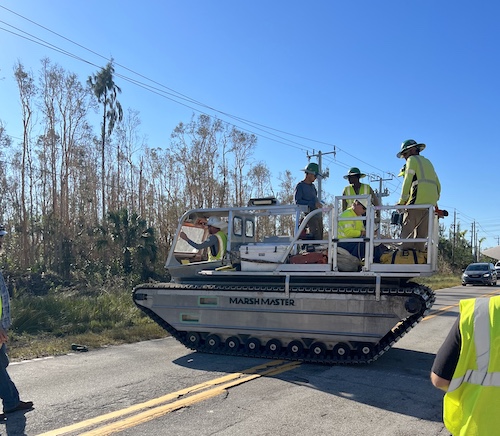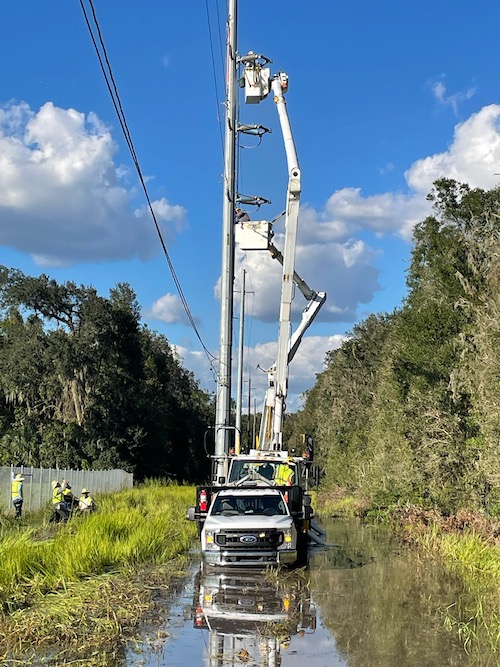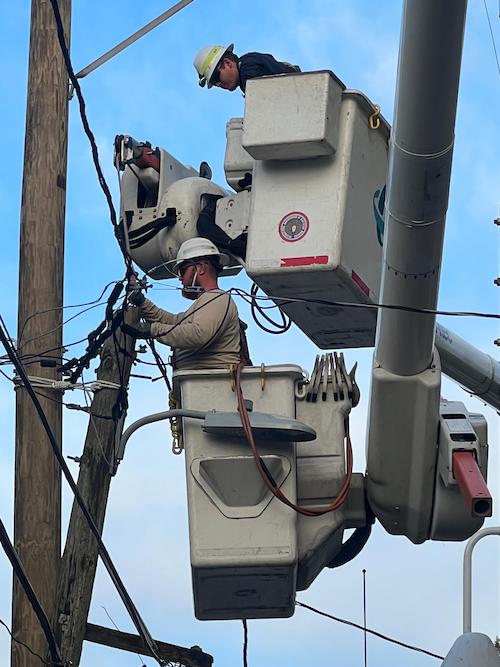Linemen who have seen Mother Nature at her worst couldn’t believe their eyes in the aftermath of Hurricane Ian.
Entire neighborhoods on barrier islands gone, washed into the Gulf Coast of Florida by Ian’s epic storm surge. Homes and shops and restaurants leveled by 150 mph winds or devoured by floodwaters. Cars and boats scattered and smashed as if a giant toy box had fallen from the sky.

|
| Utility workers cross the road in Florida swampland in a Marsh Master amphibious vehicle. Credit: Ryan Martin, Atlanta Local 84.
|
“I’ve worked quite a few storms, but this last one, I’ve never seen devastation like it,” said Kellen Lewis of West Palm Beach Local 1191, describing the scene on Estero Island, home to Fort Myers Beach. “The pictures don’t do it justice. You have to see it in person to really grasp what happened there.”
Ian slammed into southwestern Florida just shy of a Category 5 hurricane the afternoon of Sept. 28, making its way to the Carolinas two days later, weaker but still vicious. With more than 100 people confirmed dead, it was Florida’s most lethal storm in 90 years and the nation’s second-deadliest this century, after Hurricane Katrina in 2005.
The storm cut power to at least 2 million customers, drawing more than 46,000 utility workers from at least 33 states to Florida and another 12,000 to the Carolinas and Virginia, the Edison Electric Institute reported.
They worked to exhaustion 16 hours a day, seven days a week, wading into the nastiest of muck in the stickiest of air, catching what shuteye they could in bunk beds or hammocks or wounded hotels.
Among the IBEW stalwarts were Floridians who’d been dealt as much misery as their neighbors.
“We had members who lost their homes or had extensive damage, up to four feet of water,” said Jack Wilson, business manager at Utility System Council 4 in Florida. “They went in and stripped the drywall and interior so their homes could dry out, and then they went to work to help everyone else.”
Crews restored power to better than 90% of customers in Florida within five days, and to everyone else by mid-October, other than homes and businesses too damaged to be reconnected.
“You look at how fast they do it — millions were out of power, and in days their power was back,” Fifth District International Vice President Brian Thompson said. “We’ve become so good at it because, unfortunately, we go through it so often.”
Yet he has a sense of awe every time.
“When you see all those lines of trucks coming in, it’s almost like poetry in motion,” Thompson said. “Those linemen have one thing in mind: to help people and get their lights on. And they drop everything and put themselves in harm’s way to do it.”
VETERANS of Florida storms liken Ian’s wrath to the catastrophes of hurricanes Andrew in 1992 and Charley in 2004. But less infamous monsters also spring to mind as they reflect on decades of experience across the Southeast’s hurricane belt.
Heavy equipment operator Ryan Martin had none of that context when he and fellow hurricane rookie Elliot Milovich headed south from Pennsylvania in a Kuharchik Construction digger derrick as Ian prepared to strike.

|
| IBEW utility crews at Tampa Electric, above, navigate floodwaters to restore customers’ power; below, a Duke Energy IBEW linemen at work. Photos courtesy of the utilities.
|

|
“You see all this stuff on TV, but it’s something else to be able to be there firsthand and see the pure destruction,” Martin said. “The water, the flooding — that was the biggest thing, the areas it reached and distance from the bay and ocean. It’s really hard to grasp having six, seven feet of water a mile inshore.”
Martin’s hometown is Berwick, Pa., but he runs a crane on IBEW outside construction projects all over the country on a ticket from Atlanta Local 84. He’d worked winter storms, but nothing tropical until Ian.
He and Milovich, a traveler out of Omaha Local 1525, were en route to Daytona International Speedway when they learned flooding had shut it down as a staging area. They were rerouted twice, including to the Baltimore Orioles’ spring training stadium in Sarasota, before setting up camp for a week with an army of utility workers at the Collier County fairgrounds in Naples.
Their assignments included setting and straightening power poles in swampland, which they navigated in amphibious Marsh Master vehicles. The curious hybrids are part swamp buggy, part pontoon boat atop a set of all-terrain tank tracks.
“They’re awesome. They back right up to the poles, and guys can climb without having to get their gear in the water,” Martin said. “Guys on the ground are able to stand on the deck and hand line material, tools and pick wire without getting wet.”
They also worked with linemen in residential areas where power had to be cut off home by home for owners to make repairs
Lewis, of Local 1191 at Florida Power & Light Co., said it’s counterintuitive for a lineman to cut power, but “it’s safety for us and safety for the homeowner.”
“We’re used to hooking up the power, so it definitely goes against the grain for us,” he said. “But the storm surge was so high and all these homes had been completely underwater. All the wiring has to be inspected and replaced, they need new breaker panels — all that has to be done before we can turn their power back on.”
Lewis described an Estero Island neighborhood exuding classic Florida charm where FPL crews had the disconnection process down to a science
“It probably took five minutes per home,” he said. “We cut the services in the air, dropped them to the ground and coiled them against each house.”
With service lines isolated and de-energized, he said, crews reset or replaced poles and re-sagged distribution lines, ensuring that houses could be reconnected as soon as owners were ready.
OVERHEAD, bright postcard-perfect skies dominated much of the early restoration work. Underfoot, it was anything but paradise: foul muck and standing water churned from the ocean floor and tainted by the contents of ruptured septic systems. “You know what low tide smells like? Well, it was that smell with sewage mixed in,” Lewis said.
Martin was thankful he’d packed antimicrobial spray, which he and Milovich applied religiously to their boots, clothing and digger. The truck doubled as their sleeping quarters, with Milovich stringing a makeshift hammock below the winch and Martin attaching a mosquito tent to the rear.
The staging site was packed with RVs converted to bunk beds, “16 guys to a trailer,” Martin said. But with a pregnant wife at home, he opted for fresh — albeit muggy — air to minimize the risk of getting sick.
He and Milovich also jury-rigged a shower outdoors using a five-gallon bucket, garden hose and spray nozzle, avoiding long lines at the camp’s facilities and the inevitable moment when hot water — or all water — ran out.
Lewis’s FPL crew on Estero Island had a few more comforts; without space nearby for bunk-filled trailers, they slept at the otherwise-closed Sanibel Marriott. But with elevators and air conditioning out of service when they checked in, it was no-frills.
“The reason I’m over there is to help people who don’t even have a bathroom to use, don’t have a shower, maybe they don’t even have a home anymore,” he said. “As long as you have that mindset, the rest of the stuff shouldn’t bother you.”
Lewis moved to Florida from Hawaii after high school and trained as a firefighter/EMT, switching careers after marrying the daughter of an IBEW lineman. In his 12 years at FPL, he’s worked storms across the Southeast and as far north as New Jersey.
“I’m very, very blessed to have the family unit that I have,” said the father of two. “My wife understands the trade and the sacrifices we have to make, and my kids are getting there. They know this is Daddy’s trade and that we have a special skill set and when we’re called on to help, we go.”
IBEW LEADERS can’t say enough about the dedication of brothers and sisters on the front lines. But they also are deeply concerned about members and their families who are suffering in Ian’s wake.
While there’s no official count, several business managers estimated that 10% to 15% of members are affected — living in water-logged homes or without roofs and worrying about steep deductibles. Some lack insurance altogether due to Florida’s sky-high premiums.
Gregory Krumm, business manager of Fort Myers Local 1933, said he made it through “six pretty intense hours” of 100 mph wind and rain at his own home. But he heard harrowing tales — a barn splitting apart and flying into a member’s house, another who “had a baby on Monday and lost his home on Wednesday.”
Thompson said the Fifth District Unity Fund stands ready to help IBEW storm victims in Florida and Puerto Rico, where Hurricane Fiona in mid-September caused flooding and mudslides that took out roads and bridges, trapping residents in mountain communities and killing 13.
“We have reached out to locals for donations earmarked for hurricane relief, and they are reaching out to members to determine who needs help,” he said. “Every dollar raised will go directly to members who need assistance.”
Meanwhile, the mop-up continues. Business managers, including Krumm, Steve Carroll of Punta Gorda Local 641 and Phil Davis of Local 1191, as well Wilson at the System Council U-4, said they expected long days and weeks for crews until at least Thanksgiving.
Their efforts were complicated by the return of typical late-day storms after a post-Ian reprieve. Wet, windy weather in late October was keeping the ground saturated and delivering one gust too many for unstable trees and dangling limbs.
“There are still trees coming down and wires coming down” Wilson said. “Our guys are tired.”
But Ian is only part of the reason.
“It didn’t start with the hurricane,” he said. “May through October, if you’re a lineman in Florida, you know you’re going to be working seven days, 14 hours, 16 hours because of the volume of storms. We still get thunder and lightning every afternoon.”
He was frustrated to see state leaders hold a congratulatory news conference in October with only police officers, firefighters and medics.
“The police departments and sheriffs’ departments and EMS and fire, they’re all standing with the governor as first responders,” Wilson said. “It’s a little disheartening to me that our guys didn’t get some of that recognition.”
But in one sense they did, as first-timer Martin found out —even if it wasn't the public show of support they deserved.
“The response from people we helped was unbelievable. They were so happy and grateful,” he said. “It made you feel really good about being there. I would definitely do it again, 100%.”